Welcome back to the replay of Chrono Trigger! Last time we covered the destruction of Zeal, and ended with your first major battle with Lavos…
It’s a trope that the older we get, the more we fear death. All these years later, Crono’s death during that first confrontation with Lavos still shocks me. Usually, the repercussions of any gaming death are easily fixable with a continue or extra life. He’s the main character. He’s not supposed to die, right? But no, Crono was really dead. For a silent hero, Crono’s actions sang volumes just by his willingness to sacrifice himself without a moment’s hesitation. Even Magus, the arch villain until that point, appears shocked. And if you’re strong enough, you can go fight Lavos again without Crono and beat the game.
Originally, Chrono Trigger writer, Masato Kato, wanted to keep Crono dead. To continue the mission, the party would actually have to recruit a younger version of Crono. But Square deemed it too depressing and requested that the rest of the story be written in a way that he can still be saved. Depending on your perspective, the next sequence was either the most intriguing rescue mission devised, or the cheesiest part of the game. The characters use a time egg to initiate the eponymous “chrono trigger” and save Crono’s life. I really liked it and even if it was a bit deus ex machina, I thought it was a clever use of time travel, though it did make me wonder, if they could freeze time like that, why not also kill Lavos in the process?
It’s after this point that Chrono Trigger essentially becomes open world and open time. You can go anywhere, anywhen, and undertake multiple sidequests. It’s one of my favorite parts of the game because many of the adventures are character-driven segments that reveal more about your party members. I also appreciated how every decision you make impacts the ending and the way the quests play out. If anything, it’s an allegorical representation of time with all its branching pathways.
The Second Trial and the Origin of Robots
Almost every character gets a subquest, and my favorites were those involving Marle and Robo. In the first part of the retrospective, I wrote about how much I enjoyed the trial sequence. I didn’t know there was actually a second trial and it was Marle’s father, the king of Guardia, who was put in front of the jury. Accused of stealing a rainbow shell, a powerful relic that could be crafted into the best weapons, the trial only happens if you find it in the past and leave it with the king of Guardia at that era for safeguarding. In that sense, you’re responsible for the judicial woes of the monarch in the present. While the trial is short lived (you prove his innocence in a race against the clock), it leads to a touching reconciliation between Marle and her father—they’d been alienated since her mother’s death. Marle crashes through the stain glass window above the court room in an action scene befitting her character; it shows how she goes against the traditional mold, breaking sacred rites to do what is right, consequences be damned.
There are also two sidequests in which Robo plays a key role. The first involves a desert bereft of plantation, which he spends four hundred years reforesting. It’s one of the most graphic representations of your team’s effect on time, visually altering the map and giving life where there was none. His efforts take on an even more tragic light considering that in a few hundred years, his work would be rendered futile by Lavos’s awakening. Robo’s more despondent sidequest involves discovering his true identity in the apocalyptic future. His actual designation is Prometheus, and under his original programming Robo was to live among the humans, study them, and bring back the knowledge to the other robots in order to make the remaining people easier targets. It seems like the ultimate betrayal, a Terminator-esque twist, until we find out the future is much more complex than we’d thought. Lavos is still alive, and his children will eventually need to feed. “This world COULD sustain them…if humans were not around,” Mother Brain states. If humans continue to survive and consume Earth’s resources, Lavos would have no choice but to start sending out Lavos seeds to other planets. As Mother Brain sees it, the destruction of humanity could potentially save other worlds, since it would give Lavos no reason to leave.
Even though we had to take Mother Brain down, I couldn’t help but feel regret and sorrow. To Mother Brain, this made sense and was carried out after logical analysis pushed her in this direction. The machines could coexist with Lavos, even creating their own utopia, but the humans could not. The anthropocentric perspective is the only thing that justifies your annihilating the mechanical force, similar to the way you destroyed the Reptites in the past. Are we the good guys only because we’re human?
One of the most wry commentaries on human nature happens in the moon stone quest. You’re trying to re-energize the rock over several million years so that you can wield its power to create some rare weapons. It’s stolen in 1000AD and you track it down to the mayor of Porre, a miserly scrooge whose own family can’t stand him. He uses his money to make a mockery of those around him and even offers you ten gold to dance like a chicken. If you go back four-hundred years, meet the wife of the then mayor (the greedy one’s ancestor), you can change destiny with a simple gift. She loves jerky and when she finds out you have some, she offers you money in exchange for it. If you generously offer it to her for free, she’s so touched by your kindness, she promises to teach her children to be just as giving. When you jump back to the present, the mayor will hand you back the moon stone without requiring anything in exchange. On top of that, his family loves him for being so gracious and he seems an overall happier man. One act of kindness had huge repercussions throughout the generations.
(As a bit of an aside, the whole scene reminded me of a point I saw highlighted in Hayao Miyazaki’s The Wind Rises versus Isao Takahata’s Grave of the Fireflies. Both films cover the devastation wrought on Japan during World War II. But whereas Miyazaki’s ultimate message is of hope, Takahata’s is one of despair in The Kingdom of Madness and Dreams Miyazaki himself speculates how different each filmmaker’s work would be had they had different past experiences.)
If there’s two complaints I had about the final sequence, it’s that neither Ayla nor Crono get a special sidequest. I would have expected Ayla to have some kind of backstory with Kino. And despite Crono being the silent hero, I would have really enjoyed finding out more about who he is, what his relationship with his family is, and why he likes cats so much.
Cats are the Secret Rulers of Chrono Trigger
There are cats everywhere in Chrono Trigger. If you return to the ruins of Zeal in 12,000BC with Magus in your group, Janus’ cat Alfador will follow you around. And in Magus’ sidequest involving Ozzie and company, a cat will actually help you vanquish them. Cats have apparently won their secret war with dogs, as there are no canines present throughout the entirety of Chrono Trigger. We can even speculate that just as dogs really run the world behind Silent Hill, it’s very well possible cats are pulling the strings and their real goal is to let the humans get wiped out by Lavos so they can take over. Sorry, robots.
Yasunori Mitsuda
I’d be remiss in writing a retrospective/replay without mentioning Yasunori Mitsuda’s brilliant soundtrack. There was a period of time when I had heavy insomnia and the only thing that would consistently put me to sleep was the first CD of the 3 CD OST of Chrono Trigger. I know those tracks both consciously and subconsciously as my sleep patterns were intertwined with their melodies. Mitsuda himself, who often slept at his studio, stated that several of his dreams were inspirations for his music. He specifically did not want his tracks to fit into a genre, instead, drawing on personal themes. There’s a quality to each of them that reminds me of a reverie, a timeless sense which is part of their appeal. This ranges from Frog’s theme, streaming with nobility and loss, to Crono’s brave and bombastic track, to the intangible tragedy and intricacy of Schala’s chorus. Unfortunately, Mitsuda suffered a devastating loss when forty in-progress tracks were lost after his hard drive crashed. The stress might have been one of the factors resulting in his stomach ulcers, and he eventually needed help from Final Fantasy maestro Nobuo Uematsu to finish it up. How different would the game feel if those forty tracks had survived? Would there be any significant changes?
I wonder if there is a corresponding library for musical composers like that in Sandman for books that exist only in dreams.
Choices
One of the most innovative features Chrono Trigger gave players was the New Game+ feature, which let you restart the game with all your powers intact. You didn’t have to worry about level-grinding and could instead focus on changing history to get one of the multiple endings (thirteen when I last checked, but there could be more on the DS remake). Depending on when you defeat Lavos, you’ll get a very different universe as a result. If youbeat the game before you kill the Reptites, for example, you will usher in a new Dino Age where everyone is reptilian.
This type of freedom can be both liberating and upsetting—liberating in that you can go and do whatever you want to get a unique experience; disturbing in the sense that you might not get the complete experience. As more and more games have so many variables with different players getting divergent results, this is less like a film, where interpretation defines the experience, and more like having a unique scenario play out depending on player choice. Chrono Trigger uses this mechanic to its advantage with the New Game+ that encourages multiple playthroughs and further exploration.
But on some of the modern RPGs, they’re so vast, I feel compelled to consult FAQs and strategy guides to make sure I don’t miss anything significant even though I really don’t like using them. Chrono Trigger’s sequel, Chrono Cross, is full of instances where a “wrong” decision will prevent a given character from joining your team for the rest of the game. I can think of several contemporary games where I missed big story points other gamers raved about because of different choices I’d made. In this case, it’s more a reflection of how eager I am to experience all the main storylines of a game rather than a critique in itself of the genre. I can’t blame a given title for being too grand. In fact, I relish in the knowledge that my decisions actually impact the storyline and often live with choices that resulted in heartbreaking consequences (Dragon Age, Heavy Rain, Mass Effect, Witcher II, and Suikoden II come to mind). The potential for multiple narratives intertwining in manifold directions spurred on by the player was almost perfectly executed in Chrono Trigger, remarkable considering it came out over twenty years ago. It’s no wonder it’s considered one of the greatest games of all time.
In many ways, games were my myths growing up, the narrative language that helped me to bond with other players across religion, ideology, and race. Games like Chrono Trigger were my universal translator, the cross-cultural myth I shared with almost anyone who played it. I just wish there was a New Game+ for real life.
Peter Tieryas is the author of United States of Japan (Angry Robot, 2016) and Bald New World (JHP Fiction, 2014). His work has appeared in Electric Literature, Kotaku, Tor.com, and ZYZZYVA. He travels through time at @TieryasXu.










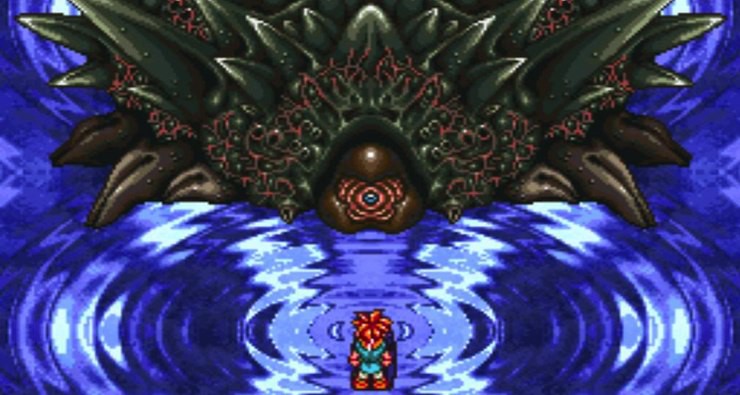
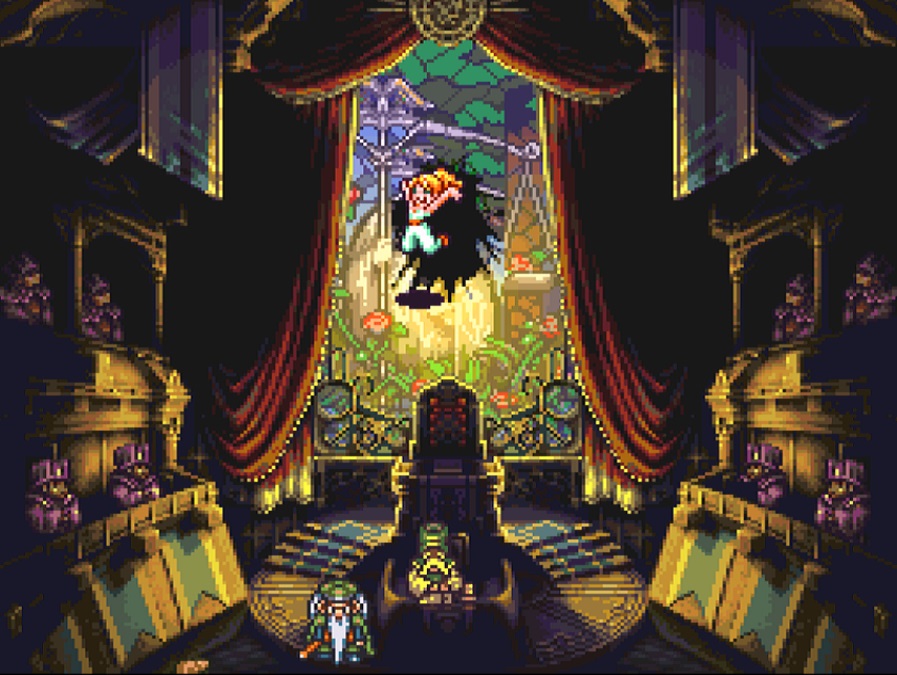
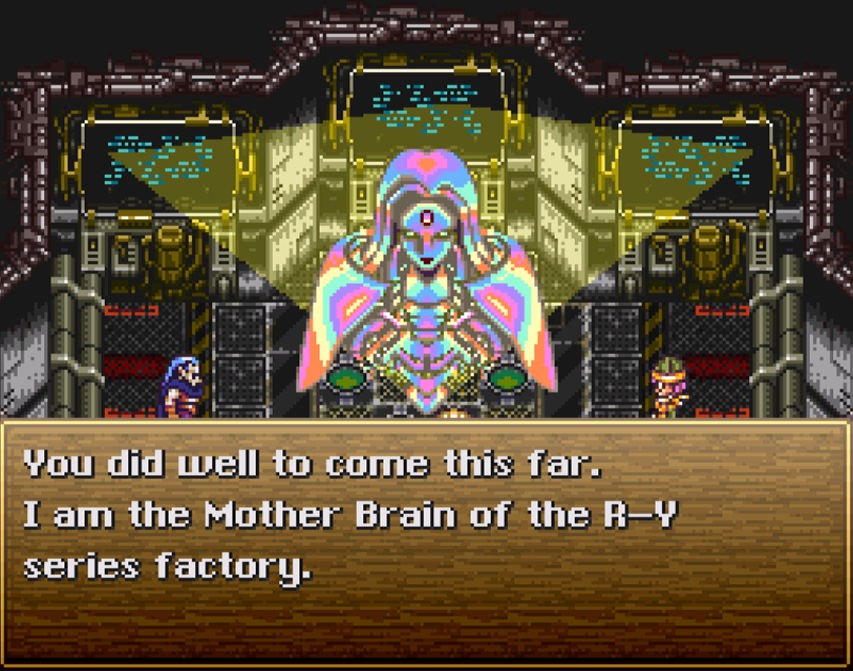
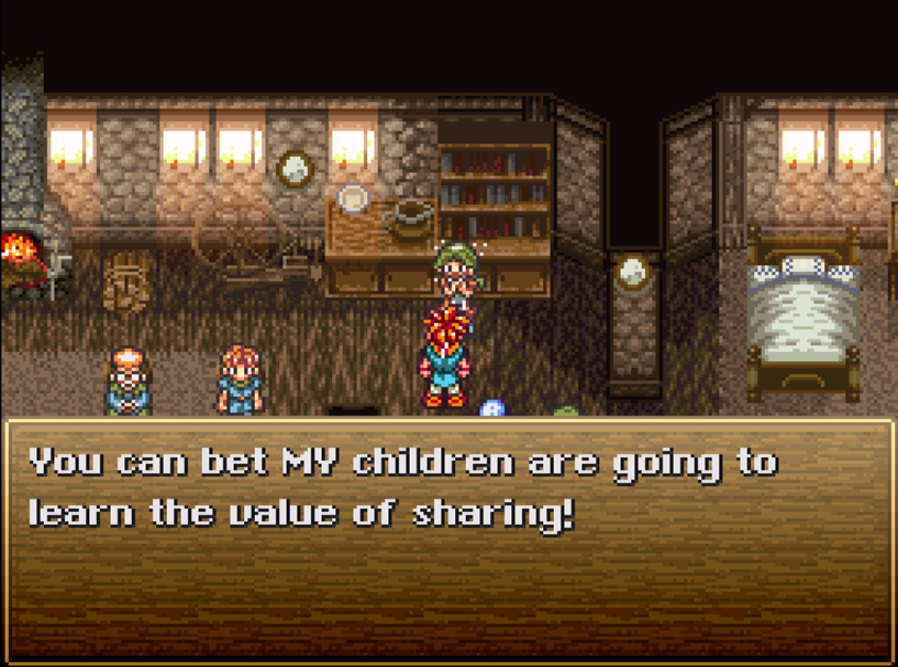
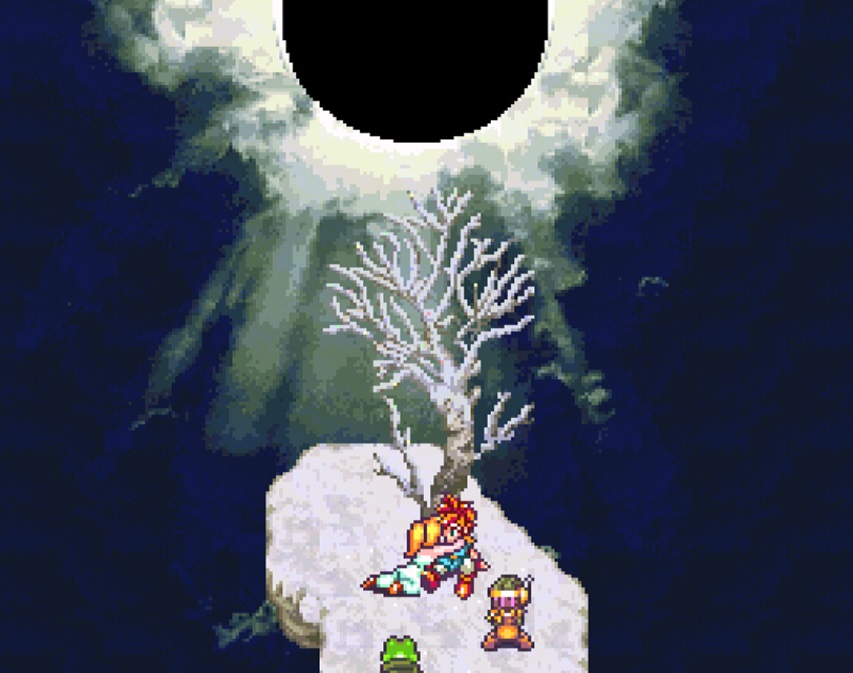
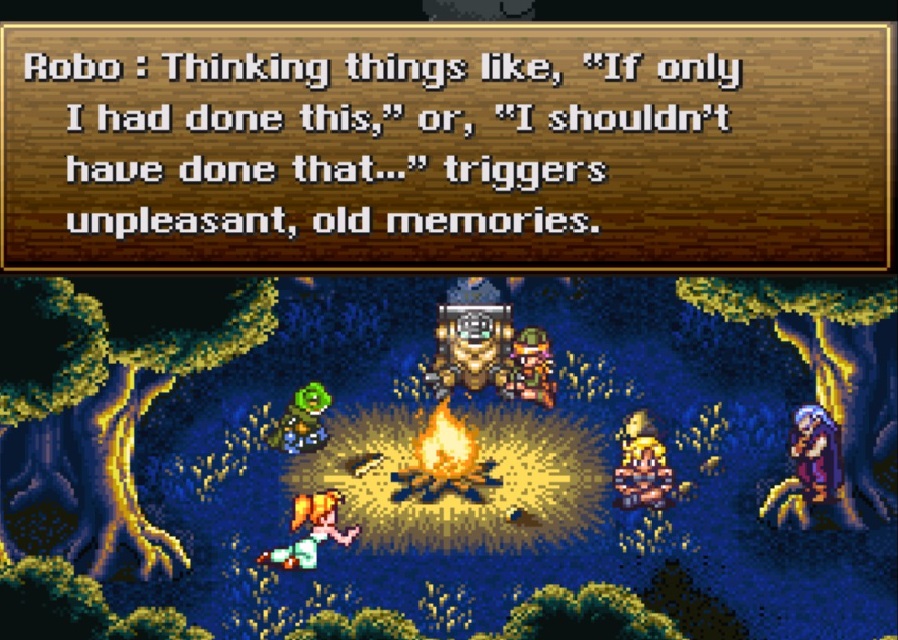
Bringing Crono back to life didn’t work for me from a narrative perspective, because as a silent protagonist, he can hardly convey the emotion of being brought back by his friends (or knowing that he’s destined to die in a few years, had the original path be chosen). Whereas seeing the gang harass Gaspar into giving them the Chrono trigger in the ending is a great moment: you see they will never give up on Crono, and after that I don’t need to see them succeed. Of course if Crono didn’t come back, we may wonder who was Doan’s ancestor. But Marle is just like Leene, so considering this ending, and what Marle thinks of Glenn as a human, I have little doubt on how the Guardia line was continued in this timeline…
I loved the second trial, because it was completely unexpected: you managed to get the rainbow shell, so at this point it’s only about crafting powerful weapons with it, right? I certainly didn’t expect to see Yakra again and get my revenge for the first trial. Also, although the king was manipulated, you see that he still didn’t trust the heroes, especially his daughter. The manipulation was more subtle than Grimma’s to Denethor in The Lord of the Rings, and I loved it. And I certainly wasn’t expecting the heroes to crash the background that way: that just doesn’t happen in a JRPG.
“His efforts take on an even more tragic light considering that in a few hundred years, his work would be rendered futile by Lavos’s awakening.”
That’s not true. Robo is just as confident as the others in the team’s success. And having seen what the future could look like, he has all the more reasons to want to improve it. Yet, the future is only terrible for the humans, Prometheus was happy before the corruption of Mother Brain: what’s really heroic is that he spends centuries to improve the future for the humans, rather than his people. No wonder his actions create a religion! By the way, some of the endings show him happy in the future with Atropos in Leene Square, showing that humans and robots can live together.
“The mayor will hand you back the moon stone without requiring anything in exchange.”
An act of generosity you repay by completely ignoring the people who need the stone in the Earthbound village. I loved Zeal, so I really hated that quest. No reason is given to justify that the stone wouldn’t be able to help them anymore.
Not only the music is great, but there is also the way it’s used. We’ve already talked about the change of music when the heroes decide to take on Lavos, but there is also the great moment of fourth wall breaking when Dalton demands to stop the music, or when Ozzie throws monsters at the heroes and the battle music comes to a stop as they fall from the conveyor belt. Priceless.
The new game+ was a great idea, and I especially appreciated that you didn’t have to play the game 13 times to get all the endings, 2 are enough (except for the minor variations for some of them). And as you said, you save a lot of time by not having to grind). I thought that was a great way to implement multiple endings.
“Cats are the Secret Rulers of Chrono Trigger”
No. “All life begins with Nu and ends with Nu. This is the truth! This is my belief!”
It’s fitting that the New Game+ feature comes up in a game about time travel. Had the idea ever been used in a game before?
‘The anthropocentric perspective’
Sorry but that middle word there now belongs to Matriarch Aethyta, they are inextricably, grammatically bound together.
Of all the sections of this game, The Faded Hour is my favorite. Like you said, there’s a ton to do and you can do it in any order you want. Checking off each quest in this game is a highlight for me. @Peter Tieryas, you say that Ayla doesn’t have a sidequest in this section, but what about the island of lost Dinos (or whatever its called)? I always thought that was her quest as it touched on the Dino Kingdom after it had been hit by Lavos in 65,000,000 BC.
@@@@@TumbleCoyote I couldn’t find any other examples before and wiki seems to indicate so. Other games had second quests, but nothing like starting a game with all your levels and powerups intact.
https://en.wikipedia.org/wiki/New_Game_Plus
@@@@@ ChocolateRob Lol =)
@@@@@Jason_UmmaMacabre I thought the same initially about Ayla, but that mission ultimately led to the rainbow shell which then led into the Marle subquest. You’re right in that it explores the fate of the Dino Kingdom, though it doesn’t reveal more about who Ayla is, giving us some insight into her character which is what I really hoped for. =)
@Athreeren Very cool points. I wonder how it would have gone if Masato Kato and Horii had their way and let Crono stay permanently dead. And totally agree. I didn’t even remember the second trial so I was really taken aback when it happened and loved it all the more. I did see the ending where Robo ends up with Atropos which made me happy for him, though I still felt pretty bleak about the chance for success (apart from it being a videogame and the idea that I would triumph in the end, ha ha) =p And you’re right about the Nu! My bad, lol
@Jason _UmmaMacabre Sorry haven’t been around since Tuesday just read your post in part 1, if you haven’t already found out, Suikoden 1 and 2 are on PS1 and now PSN for PS3 Suikoden 3, 4, and 5 are on PS2 and 3 is on PSN for PS3. 1, 2, 3, and 5 are the ones you really want to play 4 wasn’t that good, a lot of people don’t like 3 but I love it though it’s not as good as 2.
@aaron, Thanks for the info. I don’t have a PS3 or PS4, so I’m gonna have to use my Android emulator. I found a copy on Amazon, but it was really expensive. I do want to try the game though, it sounds cool. I’ll have to dig through my old Game Informer magazines and find the review.
@Peter Tieryas, speaking of the Nu, don’t forget they are the best source of Tech points if you are looking to level up your magic.
@@@@@ Aaron: Suikoden 2 was JRPG perfection. 3 was great with the three way split narrative and some unexpected twists (though the middle act with the mansion was a bit slow, ha ha). I have 1 & 5 (along with the fantastic artbook) and have been saving it for a future playthrough. I don’t know what’s going on at Konami right now, but I hope they continue the series.
@@@@@Jason_UmmaMacabre : Thx for the tip! =)
@Peter Tieryas, Anytime. You can find them in the hunting grounds in 65,000,000 BC and they only come out when it starts to rain. They knock your characters down to 1 HP every hit, but never kill them. Good luck!
@Peter Tieryas I couldn’t agree more, I also think one of the underrated aspects of 3 is that the war battles are the most satisfying as the attention you pay to the entire cast is most felt in the results. Where as in the other games it’s really just rock paper scissors, though a fun version of it to be fair.
Anyhow keep up the good work recapping CT I’m really enjoying reading these, I would love to see this become a trend on the site reviewing games like this is really interesting, learned a few new facts about the game that I never knew before.
@@@@@Jason_UmmaMacabre Very cool! thanks for clarifying on that tip!
@@@@@Aaron Thanks Aaron! Agree on Suikoden 3! And really appreciate the note! =)
This was the final part for Chrono Trigger, but Chris Lough and I are planning another one of these series with one of the Final Fantasy games. I honestly can’t wait to dive in! Thanks so much for reading!
I love how people continue to talk about Chrono Trigger: there’s just so much to say about it. The more one digs into it, the more clever the design of many parts of it becomes.
The Rainbow Shell quest is one of the highlights, especially because its being optional makes it feel more special. It’s also an excellent example of story winning over loot. I mean, the Prism Helms are very cool, but the return of the trial scene, and its resolution, are the most rewarding parts of the quest if you care about the characters and the world. But my favourite has always been the desert sidequest: that you see Robo toiling away in the overworld, the only moving character sprite apart from you, doing different things every time you pass, really changing the world itself. And then, after that, the quiet scene in the woods, where the whole company discuss the big mystery, of how and why they have been encouraged to save the world from the parasite. Lastly, that moment, where Lucca is given the opportunity to change one moment in her story that makes such a difference to her life. You’d have to have a heart of stone to not keep reloading your save until you get the correct outcome: that password’s not actually that easy to enter!
The most detailed and thorough analysis of Chrono Trigger’s story and gameplay that I’ve ever seen is The Game Design Forum’s Reversing the Design feature on it: the idea about the story up to the party’s thrashing by Lavos being the planet telling its story to the heroes is so ingenious that it’s very difficult to see the story otherwise after you hear it.
Oh dear, I can see that I’m going to be cuing up the music again… it’s all in my head anyway, but that time’s not going to spend itself.
Oh, just one last thing:
That’s stained glass window.
@13: Fascinating essay, thanks for that!
Great installment, Peter. Thank you very much: for rekindling us with such a brilliant masterpiece, and for letting younger gamers know about such a wonderful game!
Thanks @@@@@ kidentropia really appreciate the note! =)
@@@@@Chappers I’ll try to check out the essay later but I totally agree with the idea. During the campfire scene that follows Robo’s 400 year reforestation program, the party more or less speculates that it is the planet retelling its story (I explored a little bit of this in part 2 of the series as well). I tried to post a screen grab but couldn’t and here’s the exact dialogue Robo says:
“After 400 years of experience, I have come to think that Lavos may not be responsible for the gates. I have come to think that someone, or something wanted us to see all this. The different events over time, that we have witnessed. It is almost as if some entity wanted to relive its past.”
Love how every playing evokes different responses from different players! =)
In your articles, you use the word “trope” quite a bit and in a context that is popular but also incorrect. Perhaps you mean to say motif, theme, convention, or even cliche. I enjoy your writings, but struggle to get past the frequent misuse of this word.